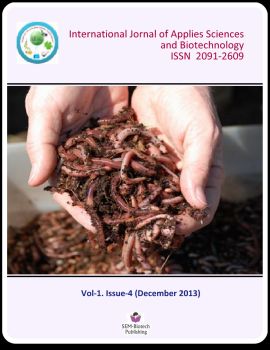Toxicity of Dietary Hibiscus sabdariffa Linn (Malvaceae) Seed to Wistar Rats
DOI:
https://doi.org/10.3126/ijasbt.v1i4.9103Keywords:
Hibiscus sabdariffa seed, Wistar rats, body weight, biochemical changes, pathological changesAbstract
In Sudan Hibiscus sabdariffa seeds after fermentation are commonly known as Furundu with high quality proteins consumed as substitute to meat mainly in the Western part of the country. The raw seed, 10, 15 and 20 % of the standard diet was fed to Wister rats for periods up to 12 weeks. These doses were found to be non-toxic but not lethal to the treated rats. There was no evidence of carcinogenic effect of Hibiscus sabdariffa seed on any of the vital organs, but the main features were depression of growth and diverse pathological changes on the liver, kidneys and intestines which were correlated with highly significant (P<0.001) elevation of serum Aspartate aminotransferase (AST), Alanine aminotransferase (ALT) and Alkaline phosphatase (ALP) activities and bilirubin (P<0.01) concentration in addition to a significant decrease (P<0.01) in cholesterol concentration. No change was observed in the total protein, globulin and urea concentrations of the test groups and albumin concentration in Groups 1 and 2 fed on diet containing 10 and 15% H. sabdarrifa seed. These findings were accompanied by leukocytosis and significantly lower red blood cells and haemoglobin concentration. Due to the elevated Mean corpuscular volume (MCV) and the normal values of the mean corpuscular Haemoglobin concentration (MCHC) in all the treatment groups the toxicity of H. Sabdariffa seed to Wistar rats resulted in macrocytic normochromic type of anaemia.
DOI: http://dx.doi.org/10.3126/ijasbt.v1i4.9103
Int J Appl Sci Biotechnol, Vol. 1(4): 214-219
Downloads
1228
458




